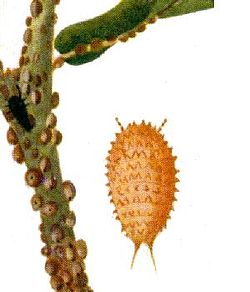| Eriococcidae | |
|---|---|
 | |
| Eriococcus coriaceus the gumtree scale | |
| Scientific classification | |
| Kingdom: | Animalia |
| Phylum: | Arthropoda |
| Class: | Insecta |
| Order: | Hemiptera |
| Suborder: | Sternorrhyncha |
| Superfamily: | Coccoidea |
| Family: | Eriococcidae |
| Genera | |
See text | |


Eriococcidae is a family of scale insects in the order Hemiptera. They are commonly known as felt scales or eriococcids. As of 2023, there are 109 genera and 681 species. [1] Each species is usually specific to a different plant host, or closely related group of hosts.
Contents
Recent research using ribosomal DNA has shown that the family Eriococcidae is not a single monophyletic group but is an aggregation of several different groups. [2] Some species that appear morphologically similar seem to be only distantly related while dissimilar species are sometimes more closely related. [3] The type genus Eriococcus has been shown to be polyphyletic. [3]